Abstract
Serum levels of properdin, Factor B and C3 and the ability of these sera to opsonize E. coli 075 were measured in 17 patients with surgical infections ranging in severity from mild to fatal. There was good direct correlation between severity of infection, serum levels of properdin and C3, and the ability of the serum to support opsonization. The levels of Factor B were not significantly reduced when measured by radial immunodiffusion, but immunoelectrophoresis showed conversion. Restoration of full opsonic activity was accomplished only by the addition of a combination of C3, Factor B, and properdin in excess. The findings provide evidence that severe bacterial infection causes a consumption of opsonic proteins which may result in a reduced ability of the patient's serum to opsonize bacteria and thereby further increase susceptibility to infection.
Full text
PDF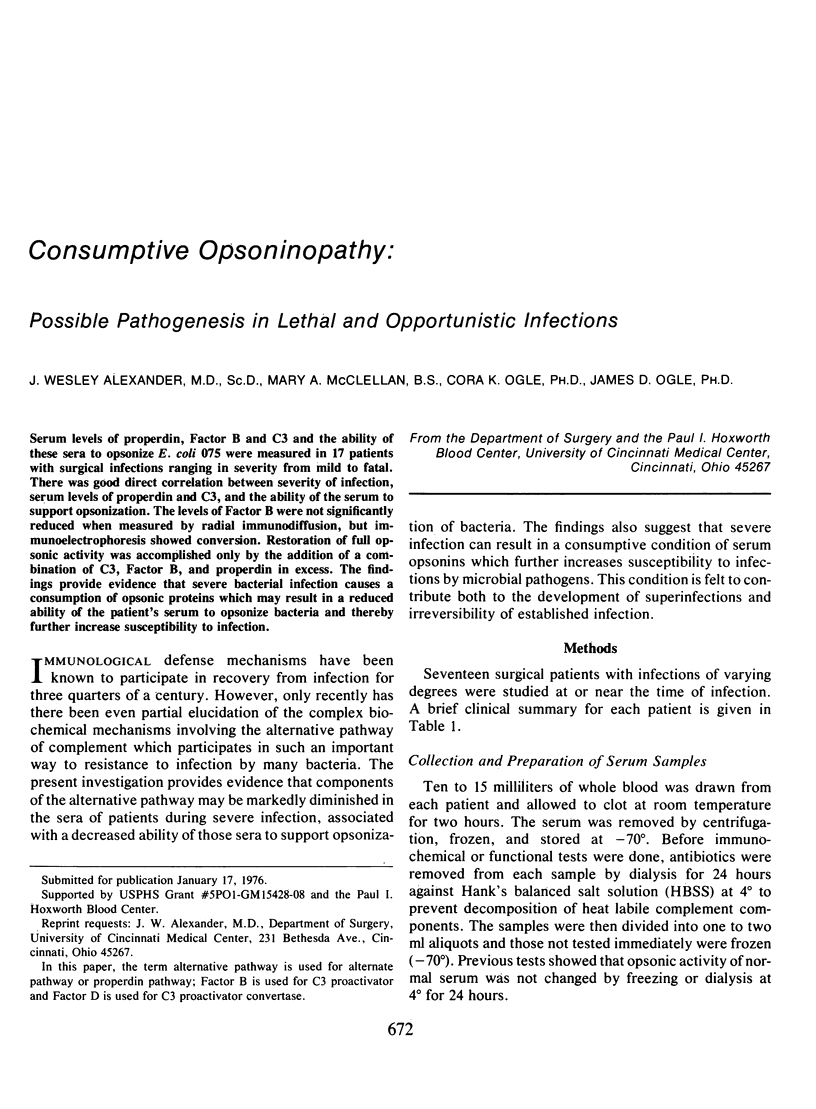
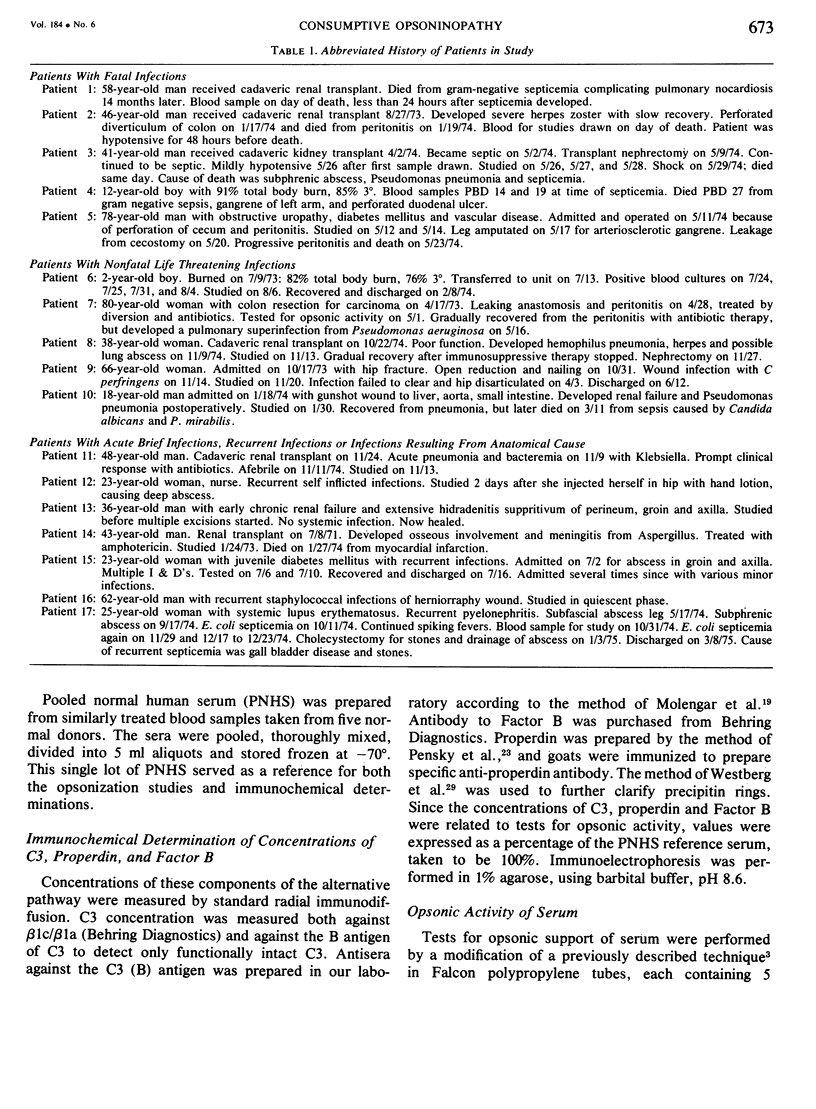
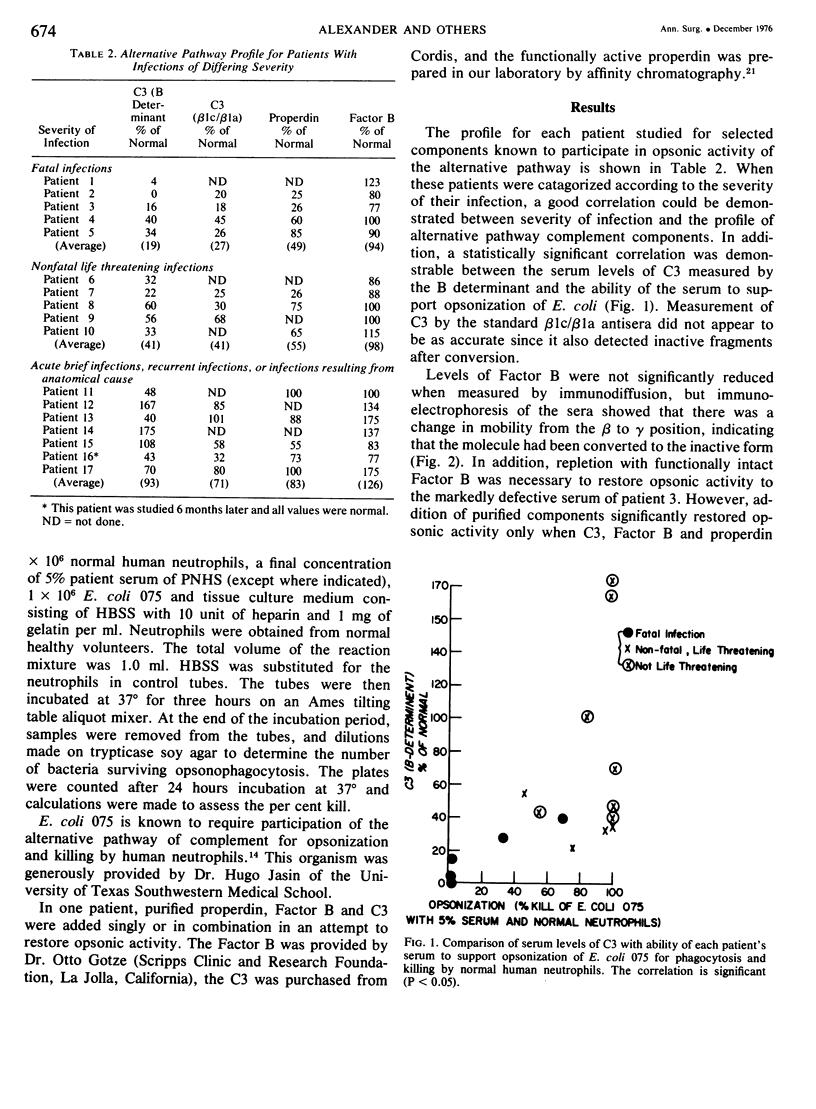
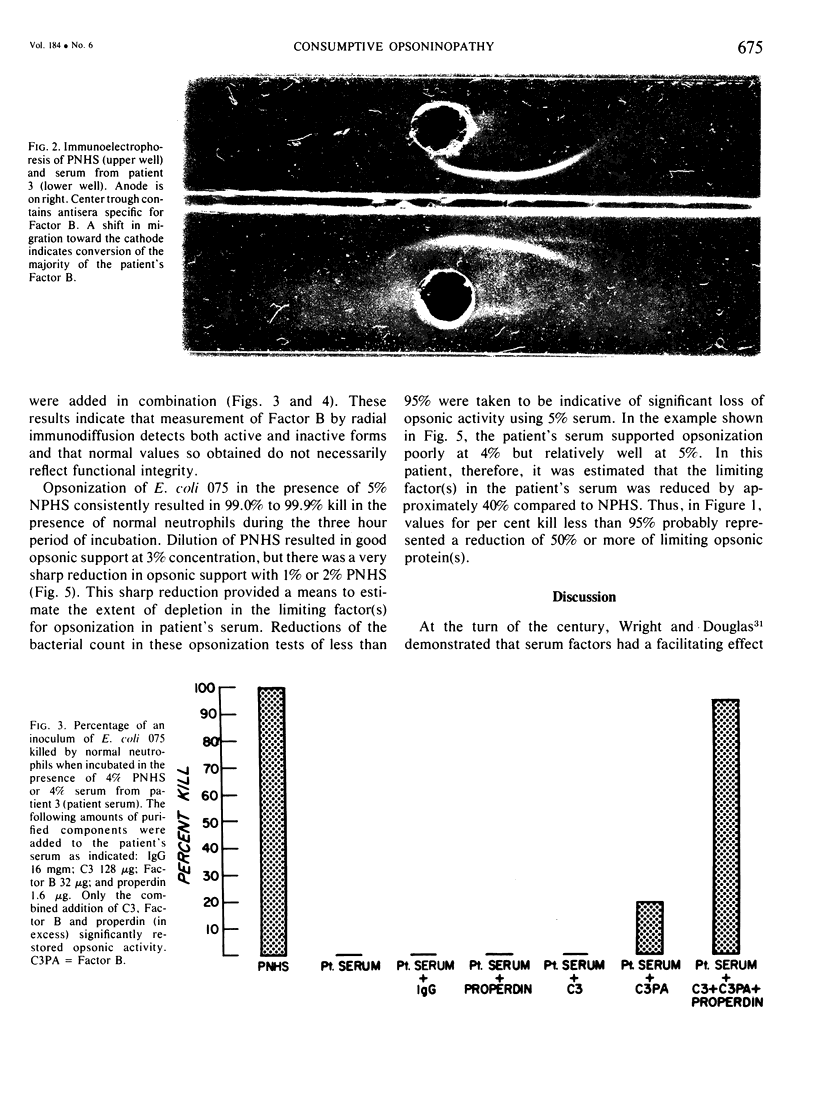

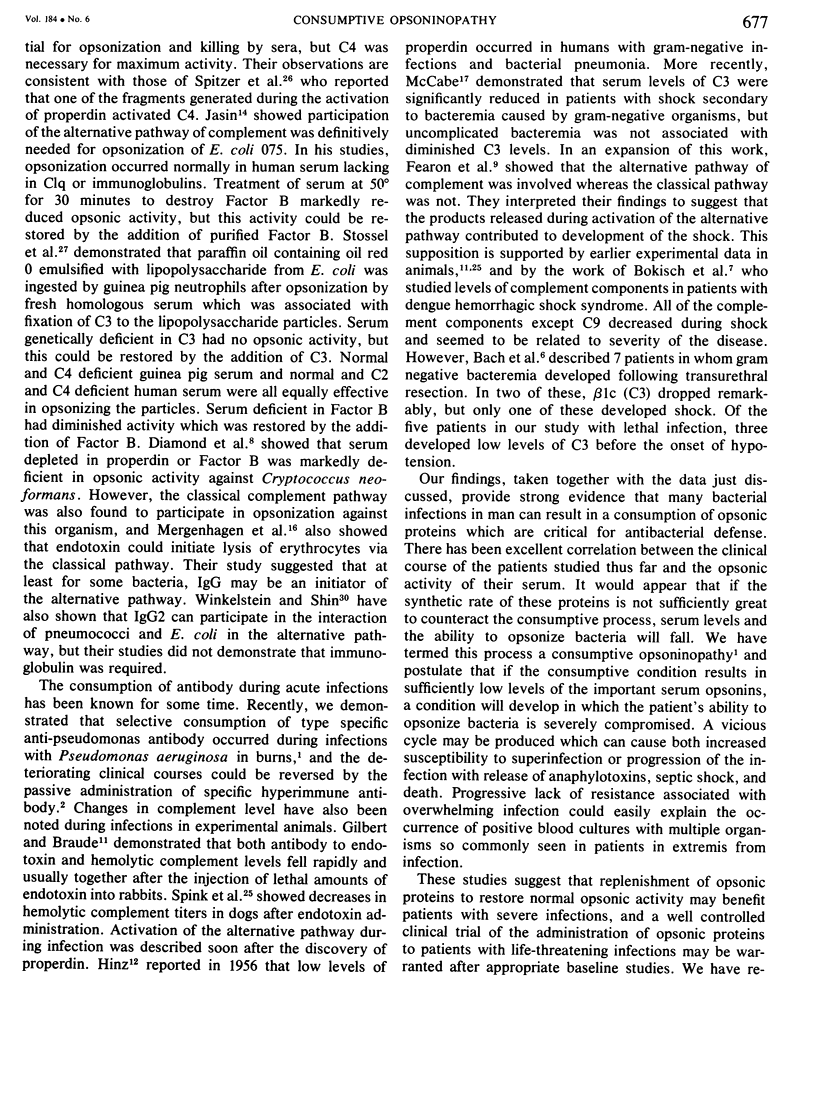
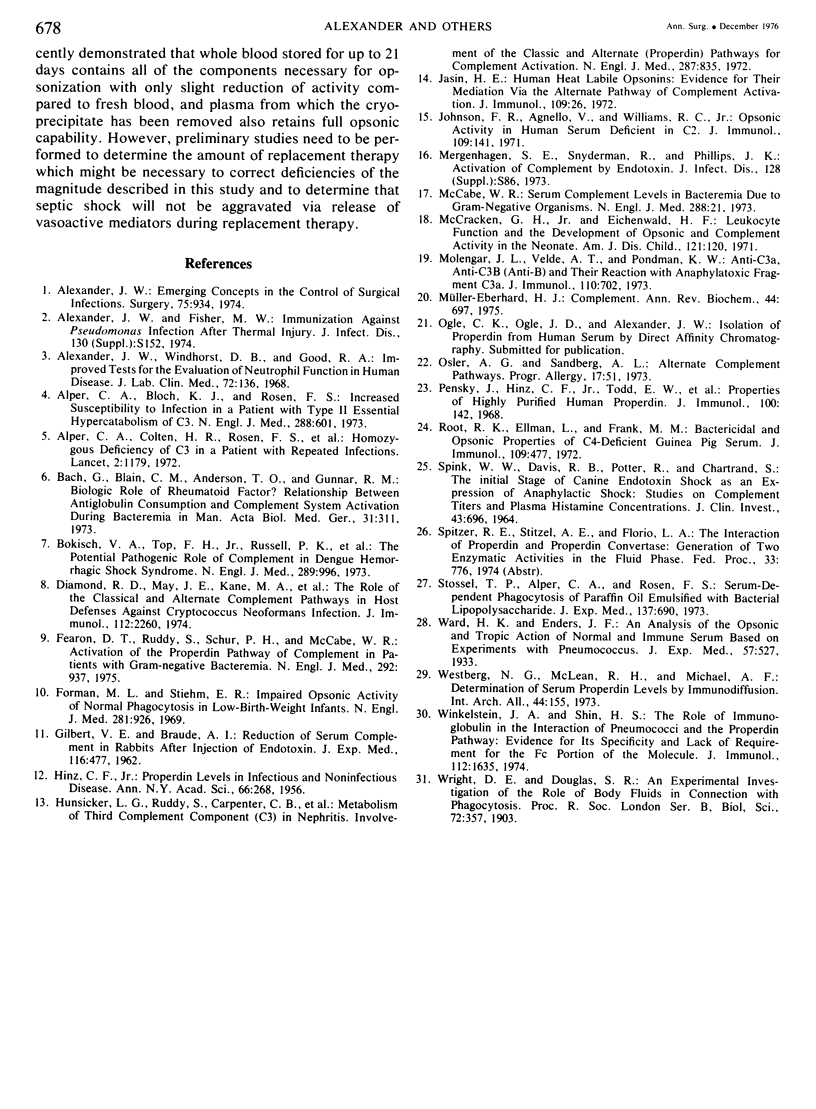
Images in this article
Selected References
These references are in PubMed. This may not be the complete list of references from this article.
- Alexander J. W. Emerging concepts in the control of surgical infections. Surgery. 1974 Jun;75(6):934–946. [PubMed] [Google Scholar]
- Alexander J. W., Windhorst D. B., Good R. A. Improved tests for the evaluation of neutrophil function in human disease. J Lab Clin Med. 1968 Jul;72(1):136–148. [PubMed] [Google Scholar]
- Alper C. A., Bloch K. J., Rosen F. S. Increased susceptibility to infection in a patient with type II essential hypercatabolism of C3. N Engl J Med. 1973 Mar 22;288(12):601–606. doi: 10.1056/NEJM197303222881204. [DOI] [PubMed] [Google Scholar]
- Alper C. A., Colten H. R., Rosen F. S., Rabson A. R., Macnab G. M., Gear J. S. Homozygous deficiency of C3 in a patient with repeated infections. Lancet. 1972 Dec 2;2(7788):1179–1181. doi: 10.1016/s0140-6736(72)92598-6. [DOI] [PubMed] [Google Scholar]
- Bach G. L., Blain C. M., Anderson T. O., Gunnar R. M. Biologic role of rheumatoid factor? Relationship between antiglobulin consumption and complement system activation during bacteremia in man. Acta Biol Med Ger. 1973;31(2):311–316. [PubMed] [Google Scholar]
- Bokisch V. A., Top F. H., Jr, Russell P. K., Dixon F. J., Müller-Eberhard H. J. The potential pathogenic role of complement in dengue hemorrhagic shock syndrome. N Engl J Med. 1973 Nov 8;289(19):996–1000. doi: 10.1056/NEJM197311082891902. [DOI] [PubMed] [Google Scholar]
- Diamond R. D., May J. E., Kane M. A., Frank M. M., Bennett J. E. The role of the classical and alternate complement pathways in host defenses against Cryptococcus neoformans infection. J Immunol. 1974 Jun;112(6):2260–2270. [PubMed] [Google Scholar]
- Ensky J., Hinz C. F., Jr, Todd E. W., Wedgwood R. J., Boyer J. T., Lepow I. H. Properties of highly purified human properdin. J Immunol. 1968 Jan;100(1):142–158. [PubMed] [Google Scholar]
- Fearon D. T., Ruddy S., Schur P. H., McCabe W. R. Activation of the properdin pathway of complement in patients with gram-negative of bacteremia. N Engl J Med. 1975 May 1;292(18):937–940. doi: 10.1056/NEJM197505012921802. [DOI] [PubMed] [Google Scholar]
- Forman M. L., Stiehm E. R. Impaired opsonic activity but normal phagocytosis in low-birth-weight infants. N Engl J Med. 1969 Oct 23;281(17):926–931. doi: 10.1056/NEJM196910232811704. [DOI] [PubMed] [Google Scholar]
- GILBERT V. E., BRAUDE A. I. Reduction of serum complement in rabbits after injection of endotoxin. J Exp Med. 1962 Oct 1;116:477–490. doi: 10.1084/jem.116.4.477. [DOI] [PMC free article] [PubMed] [Google Scholar]
- Jasin H. E. Human heat labile opsonins: evidence for their mediation via the alternate pathway of complement activation. J Immunol. 1972 Jul;109(1):26–31. [PubMed] [Google Scholar]
- Johnson F. R., Agnello V., Williams R. C., Jr Opsonic activity in human serum deficient in C2. J Immunol. 1972 Jul;109(1):141–145. [PubMed] [Google Scholar]
- McCracken G. H., Jr, Eichenwald H. F. Leukocyte function and the development of opsonic and complement activity in the neonate. Am J Dis Child. 1971 Feb;121(2):120–126. doi: 10.1001/archpedi.1971.02100130074008. [DOI] [PubMed] [Google Scholar]
- Molenaar J. L., ten Velde A., Pondman K. W. Anti-C3a, anti-C3B (anti-B) and their reaction with the anaphylatoxic fragment C3a. J Immunol. 1973 Mar;110(3):702–708. [PubMed] [Google Scholar]
- Müller-Eberhard H. J. Complement. Annu Rev Biochem. 1975;44:697–724. doi: 10.1146/annurev.bi.44.070175.003405. [DOI] [PubMed] [Google Scholar]
- Osler A. G., Sandberg A. L. Alternate complement pathways. Prog Allergy. 1973;17(0):51–92. [PubMed] [Google Scholar]
- Root R. K., Ellman L., Frank M. M. Bactericidal and opsonic properties of C4-deficient guinea pig serum. J Immunol. 1972 Sep;109(3):477–486. [PubMed] [Google Scholar]
- SPINK W. W., DAVIS R. B., POTTER R., CHARTRAND S. THE INITIAL STAGE OF CANINE ENDOTOXIN SHOCK AS AN EXPRESSION OF ANAPHYLACTIC SHOCK: STUDIES ON COMPLEMENT TITERS AND PLASMA HISTAMINE CONCENTRATIONS. J Clin Invest. 1964 Apr;43:696–704. doi: 10.1172/JCI104954. [DOI] [PMC free article] [PubMed] [Google Scholar]
- Stossel T. P., Alper C. A., Rosen F. S. Serum-dependent phagocytosis of paraffin oil emulsified with bacterial lipopolysaccharide. J Exp Med. 1973 Mar 1;137(3):690–705. doi: 10.1084/jem.137.3.690. [DOI] [PMC free article] [PubMed] [Google Scholar]
- Westberg N. G., McLean R. H., Michael A. F. Determination of serum properdin levels by immunodiffusion. Int Arch Allergy Appl Immunol. 1973;44(1):155–160. doi: 10.1159/000230924. [DOI] [PubMed] [Google Scholar]
- Winkelstein J. A., Shin H. S. The role of immunoglobulin in the interaction of pneumococci and the properdin pathway: evidence for its specificity and lack of requirement for the Fc portion of the molecule. J Immunol. 1974 May;112(5):1635–1642. [PubMed] [Google Scholar]



